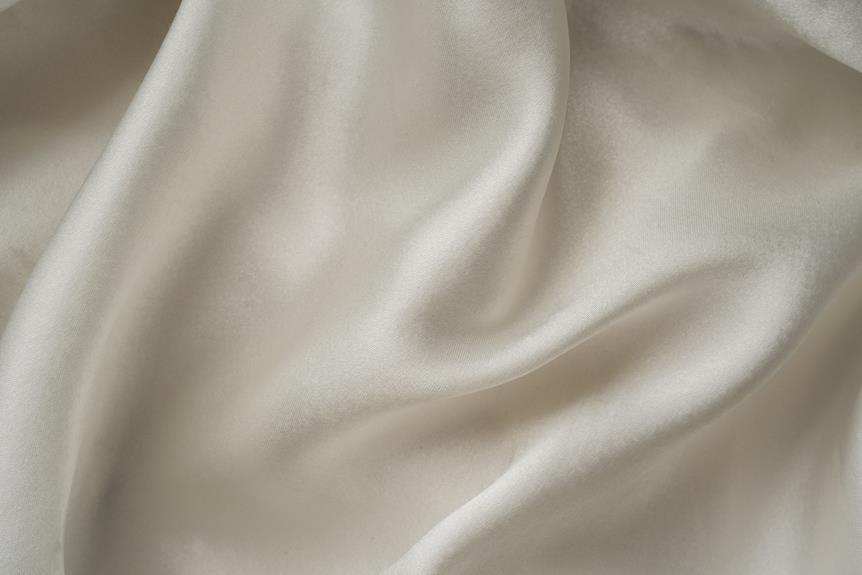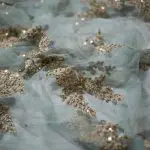So, you're wondering if chiffon is see-through? You've come to the right place for a comprehensive fabric insight.
Understanding the transparency of chiffon involves delving into its origins, composition, weaves, and influencing factors. This concise guide will provide you with the mastery you seek in navigating the sheerness of chiffon.
From styling tips to care and maintenance, you'll be equipped with the knowledge to confidently incorporate sheer chiffon into your wardrobe.
Let's embark on this fabric exploration and unveil the secrets of chiffon's transparency.
Key Takeaways
- Chiffon fabric is a delicate and balanced combination of synthetic and natural fibers.
- Chiffon is often see-through, but higher thread count chiffon and darker shades offer more coverage.
- Chiffon can be woven in various ways, such as plain weave, twill weave, georgette weave, crepe chiffon, and organza weave.
- Styling tips for sheer chiffon include layering, pairing with structured pieces, embracing flowy silhouettes, and incorporating chiffon accents.
The Origins of Chiffon
Chiffon fabric originated in France during the 18th century, known for its light and sheer qualities. Its historical significance lies in its association with high fashion and luxury. Chiffon was originally made from silk, a delicate and luxurious material. Silk production was a closely guarded secret in China for thousands of years, and it eventually made its way to Europe through the Silk Road. The introduction of chiffon marked a significant moment in the fashion world, as it allowed for the creation of ethereal and delicate garments that were highly sought after by the elite.
The production of silk, and subsequently chiffon, revolutionized the textile industry and played a crucial role in shaping the fashion landscape. The intricate process of creating chiffon from silk fibers contributed to its exclusivity and allure. Understanding the historical significance of chiffon and its connection to silk production provides valuable insight into the evolution of fashion and the enduring appeal of this exquisite fabric.
Understanding Chiffon's Composition
To understand chiffon's composition, you can examine the fabric's unique blend of textile fibers. Chiffon is composed of a delicate and balanced combination of synthetic fibers such as polyester, nylon, and rayon, as well as natural fibers like silk. This blend of fibers gives chiffon its distinctive light and airy quality, making it a popular choice for elegant and flowing garments.
When understanding chiffon's composition, it's important to consider its fabric durability, which is influenced by the following:
- Fiber Blend: Chiffon's composition includes a mix of synthetic and natural fibers, providing a balance between strength and comfort.
- Lightweight Nature: The fine, sheer texture of chiffon is achieved through its composition, creating a lightweight fabric that drapes beautifully but requires careful handling.
- Sheerness: The composition of chiffon contributes to its semi-transparency, adding an ethereal quality to garments made from this fabric.
- Breathability: Chiffon's composition allows for good airflow, making it a comfortable choice for warm weather clothing.
- Care Requirements: Understanding chiffon's composition is essential for maintaining its fabric durability, as it often requires delicate care due to its delicate nature.
The Sheerness of Chiffon
Chiffon's sheerness is one of its defining characteristics. It's a delicate, lightweight fabric that often has a see-through quality. This transparency gives chiffon a graceful, ethereal appearance that makes it a popular choice for elegant and formal attire.
Chiffon's sheerness adds a touch of sophistication to any outfit. The way it drapes and flows creates a romantic and feminine look that is perfect for special occasions. Whether it's a flowing chiffon gown or a sheer chiffon blouse, this fabric exudes elegance and glamour.
In addition to its aesthetic appeal, chiffon is also a practical choice. Its lightweight nature makes it comfortable to wear, especially in warmer weather. The fabric's airy quality allows for breathability, preventing the wearer from feeling too hot or restricted.
Transparency of Chiffon
When examining the transparency of chiffon, hold the fabric up to a light source to gauge its sheerness. Chiffon is renowned for its delicate and sheer nature, making it a popular choice for elegant and romantic styles.
Here are some key factors to consider when evaluating the transparency of chiffon:
- Thread Count: Higher thread count chiffon tends to be less sheer, offering more coverage.
- Color: Lighter colors may appear more transparent than darker shades.
- Layering: Layering chiffon can enhance its opacity, providing more coverage when desired.
- Quality: Higher quality chiffon is often less see-through due to denser weaving.
- Lining: Adding a lining underneath chiffon garments can greatly influence their transparency, allowing for more versatility in styling options.
Chiffon's Delicate Appearance
When examining chiffon's delicate appearance, you can easily gauge its sheerness by holding it up to a light source. The fabric's transparency gives it an ethereal feel, making it a popular choice for elegant and romantic clothing. Chiffon's delicate drape adds an effortless grace to any garment, but its sheer nature can also be a styling challenge. To make the most of chiffon's delicate appearance, consider layering it with a slip dress or using it as an overlay on a more opaque fabric. When caring for chiffon, hand-washing or using the delicate cycle on your washing machine will help maintain its ethereal feel and prevent damage. Avoiding rough surfaces and sharp jewelry can also prolong the life of this delicate fabric.
| Chiffon's Delicate Drape, Styling Tips | Chiffon's Ethereal Feel, Care Tips |
|---|---|
| Layer with a slip dress for opacity | Hand-wash or use delicate cycle |
| Use as an overlay for added elegance | Avoid rough surfaces and sharp jewelry |
Types of Chiffon Weaves
So, let's talk about the different types of chiffon weaves.
The weave of chiffon fabric plays a significant role in its transparency.
Understanding the different textures and weaves of chiffon will help you choose the right type for your needs.
Weave Affects Transparency
To understand how weave affects the transparency of chiffon, you should familiarize yourself with the different types of chiffon weaves.
- Plain Weave: The most common type, it has an even and uniform texture.
- Twill Weave: Characterized by diagonal lines, this weave offers a slightly more opaque appearance.
- Georgette Weave: Similar to chiffon but with a slightly more crinkled texture, providing a semi-sheer look.
- Crepe Chiffon: This weave has a slightly grainy texture, which affects its transparency.
- Organza Weave: Known for its stiffness and sheen, it's the most transparent of chiffon weaves.
Understanding these weave variations will give you insight into how fabric opacity is influenced, allowing you to make informed choices when selecting chiffon for your projects.
Different Chiffon Textures
As you explore different chiffon textures, it's important to consider how various weave types impact the fabric's transparency. Chiffon weaves play a crucial role in determining the opacity of the fabric.
For instance, the plain weave chiffon is lightweight and sheer, making it ideal for ethereal, flowing garments.
Twisted chiffon, on the other hand, has a slightly more textured surface due to the twisted yarns, offering a bit more opacity while still maintaining the characteristic lightness of chiffon.
Another type, the satin chiffon, has a smooth, glossy surface that reflects light, giving it a more opaque appearance compared to other chiffon weaves.
Understanding these different chiffon weaves allows you to choose the perfect fabric for your desired level of fabric opacity, whether it's for a delicate evening gown or a breezy summer scarf.
Factors Influencing Chiffon Transparency
How exactly does the weight of the chiffon fabric affect its transparency? The transparency of chiffon is influenced by various factors, with the weight of the fabric being a crucial determinant. Here's a breakdown of how the weight of chiffon affects its transparency:
- Lightweight Chiffon: Lighter chiffon fabrics tend to be more transparent as they allow more light to pass through the material, resulting in a sheer and delicate appearance.
- Medium Weight Chiffon: Chiffon with a moderate weight strikes a balance between transparency and opacity. It offers a semi-sheer look, providing a level of coverage while still maintaining an airy and ethereal quality.
- Heavyweight Chiffon: Heavier chiffon fabrics are less transparent and offer more opacity. These fabrics provide a denser and more substantial appearance, making them suitable for designs that require more coverage.
Understanding how the weight of chiffon influences its transparency can help you choose the right fabric weight for your specific design needs.
Styling Tips for Sheer Chiffon
Maximize your look with sheer chiffon by incorporating these styling tips for a versatile and elegant wardrobe addition.
When it comes to styling sheer chiffon, layering is key. Use a camisole or a slip dress underneath to add coverage while still showcasing the delicate nature of the fabric. Experiment with different layering options to achieve the desired level of modesty or allure.
You can also play with contrasting textures by layering chiffon over more structured pieces like denim or leather for a modern and edgy look.
Another styling technique for sheer chiffon is to embrace the ethereal and romantic feel of the fabric. Opt for flowy silhouettes and soft draping to enhance the graceful movement of chiffon. Pair a sheer chiffon blouse with tailored trousers for a balanced and sophisticated ensemble. Additionally, consider incorporating sheer chiffon accents through scarves or flowy sleeves to add a touch of elegance to any outfit.
Incorporating sheer chiffon into your wardrobe opens up a world of styling possibilities. Whether you prefer a subtle and understated approach or want to make a statement, mastering the art of styling sheer chiffon allows for endless creativity and versatility.
Care and Maintenance for Chiffon Items
To maintain the delicate nature of your chiffon items, regularly hand wash them in cold water with a mild detergent. Avoid using harsh chemicals or bleach that can damage the fabric.
Here are some washing tips and ironing techniques to help you care for your chiffon items:
- Hand Wash: Always hand wash your chiffon items instead of using a washing machine to prevent damage.
- Use Cold Water: When washing chiffon, use cold water to avoid shrinking or damaging the fabric.
- Mild Detergent: Choose a gentle, mild detergent specifically designed for delicate fabrics.
- Avoid Wringing: After washing, avoid wringing the chiffon items as it can cause them to lose their shape and texture.
- Low Heat Ironing: If ironing is necessary, use a low heat setting and place a thin cloth between the iron and the chiffon to prevent direct heat exposure.
Following these care and maintenance tips will help preserve the texture, color, and overall quality of your chiffon items, ensuring they remain elegant and beautiful for a long time.
Frequently Asked Questions
Can Chiffon Be Dyed Easily at Home?
You can DIY dye chiffon at home, but color fastness can be a concern. It's important to use the right dye and follow proper techniques for best results. Research and test first to avoid disappointment.
What Are Some Common Misconceptions About Chiffon and Its Transparency?
Chiffon's sheer illusion often leads to fabric misconceptions. It's commonly thought to be see-through, but with the right layering or lining, chiffon can offer the perfect balance of elegance and coverage for your outfits.
Is Chiffon Suitable for Making Curtains or Other Home Decor Items?
Chiffon is a delicate fabric that adds elegance to home decor. While it's suitable for creating decorative accents like chiffon curtains, its lightweight nature requires special dyeing techniques for optimal color vibrancy and longevity.
Are There Any Specific Guidelines for Ironing Chiffon Fabric?
When ironing chiffon, use a low heat setting to prevent damage. Place a pressing cloth over the fabric to avoid direct contact with the iron. Gently press without applying too much pressure to maintain the delicate fabric's integrity.
Can Chiffon Be Layered to Increase Opacity?
Yes, chiffon can be layered to increase opacity. The layering technique involves adding multiple layers of fabric to achieve the desired level of opacity. This allows you to customize the transparency of chiffon according to your preference.
- How Does Ring Spun Cotton Affect Garment Fit and Shape Retention? - August 13, 2024
- What Are the Challenges in Producing Ring Spun Cotton? - August 13, 2024
- Is Ring Spun Cotton Suitable for Plus-Size Clothing? - August 13, 2024





